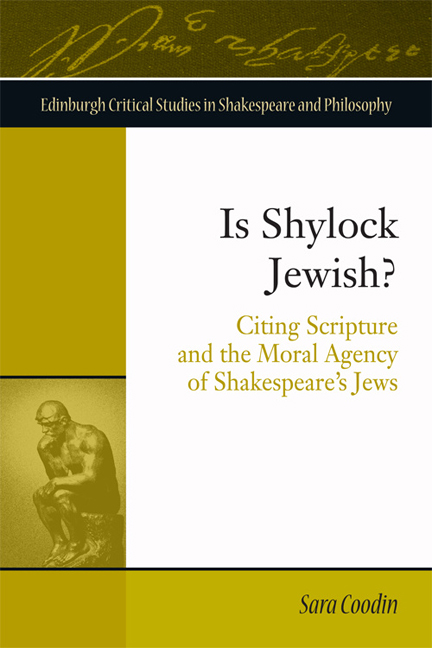Introduction: Is Shylock Jewish?
Published online by Cambridge University Press: 22 December 2017
Summary
In a 1923 essay titled ‘The Background of Shylock’, Anglo- Jewish historian Cecil Roth offers the kin d of careful forensic reconstruction of Shakespeare's fictional moneylender that one might expect of a scholar of Renaissance Jewry. Roth observes that ‘it is not difficult in our present state of knowledge to reconstruct Shylock's actual background and to depict, without leaving much margin for error, those details which Shakespeare relegated to the imagination.’ To these ends, Roth begins to narrate Shylock's Venetian existence, positing that he must have been a German Jew or, as they were referred to by their contemporary Italians, the Nazione Tedesca, the oldest and most sizeable of the three ethnographically Jewish groups living in Italy at the end of the sixteenth century, and the only group permitted to work in moneylending. Roth praises Shakespeare's verisimilitude, noting that ‘Shakespeare's intuition has enabled him to sketch in trivial details with such remarkable fidelity as to render it quite conceivable (as has been conjectured) he knew Italy at firsthand.’ Jessica's theft of her father's jewels along with his bags of ducats and the man's livery suit that she uses as a disguise, Roth observes, would have come from bond securities left by Shylock's wealthy Venetian customers who had entered into loan contracts with him. Roth notes that German Jews, unlike their Portuguese and Turkish counterparts, spoke fluent Italian; however, it was unlikely that Shylock would have been granted citizenship in sixteenth-century Venice, whose laws prohibited Jewish citizenship until the late eighteenth century. The location of the synagogue that Shylock mentions as a meeting-place with Tubal in act 3, scene 1 would not have been Venice's renowned Spanish synagogue, which Roth derides as ‘at present the show-place of the Venetian ghetto, in which sentimental tourists think of Shylock and of Jessica.’ Instead, Roth points to the city's two Ashkenazi synagogues, the Scuola Grande Tedesca founded in 1529 and the Scuola Canton founded in 1532, where services were held according to German-Jewish tradition.
- Type
- Chapter
- Information
- Is Shylock Jewish?Citing Scripture and the Moral Agency of Shakespeare's Jews, pp. 1 - 25Publisher: Edinburgh University PressPrint publication year: 2017

